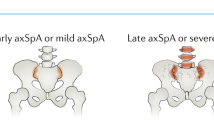Abstract
In spondyloarthritis, in particular ankylosing spondylitis (AS), a need exists for clinically meaningful biomarkers, both for diagnosis and prognosis. Earlier diagnosis has become an imperative since the advent of biologic therapy, which has proved effective in controlling axial inflammation. Presently, however, there are no biomarkers that reliably distinguish inflammatory back pain from the far more prevalent mechanical back pain. The target sites in AS—sacroiliac joints and the spine—are relatively inaccessible to the investigator and clinician, so defining markers associated with or predictive of axial inflammation remains an important goal. Cytokines, metalloproteinases, and cartilage catabolic products are all candidates for the important role of biomarker in spondyloarthritis.
Similar content being viewed by others
References and Recommended Reading
Van der Heijde D, Dougados M, Davis J, et al.: Assessment in Ankylosing Spondylitis International Working Group/ Spondylitis Association of America recommendations for conducting clinical trials in ankylosing spondylitis. Arthritis Rheum 2005, 52:386–394.
Biomarkers Definitions Working Group: Biomarkers and surrogate endpoints: preferred definitions and conceptual framework. Clin Pharmacol Ther 2001, 69:89–95.
Pages F, Berger A, Camus M, et al.: Effector memory T cells, early metastasis, and survival in colorectal cancer. N Engl J Med 2005, 353:2654–2666.
Braun J, Bollow M, Neure L, et al.: Use of immunohistologic and in situ hybridization techniques in the examination of sacroiliac joint biopsy specimens from patients with ankylosing spondylitis. Arthritis Rheum 1995, 38:499–505.
De Rycke L, Vandooren B, Kruithof E, et al.: Tumor necrosis factor alpha blockade treatment down-modulates the increased systemic and local expression of Toll-like receptor 2 and Toll-like receptor 4 in spondylarthropathy. Arthritis Rheum 2005, 52:2146–2158.
Zhang X, Glogauer M, Zhu F, et al.: Innate immunity and arthritis: neutrophil Rac and toll-like receptor 4 expression define outcomes in infection-triggered arthritis. Arthritis Rheum 2005, 52:1297–1304.
Kim TH, Stone M, Payne U, et al.: Cartilage biomarkers in ankylosing spondylitis: relationship to clinical variables and treatment response. Arthritis Rheum 2005, 52:885–891. This study analyzes the profile of serum markers of cartilage breakdown in patients with AS.
Smith GW, James V, Mackenzie DA, et al.: Ankylosing spondylitis and secretor status: a re-evaluation. Br J Rheumatol 1997, 36:778–780.
Spoorenberg A, van der Heijde D, de Klerk E, et al.: Relative value of erythrocyte sedimentation rate and C-reactive protein in assessments of disease activity in ankylosing spondylitis. J Rheumatol 1999, 26:980–984.
Rudwaleit M, Listing J, Brandt J, et al.: Prediction of a major clinical response (BASDAI 50) to tumour necrosis factor alpha blockers in ankylosing spondylitis. Ann Rheum Dis 2004, 63:665–670.
Ruof J, Stucki G: Validity aspects of erythrocyte sedimentation rate and C-reactive protein in ankylosing spondylitis: a literature review. J Rheumatol 1999, 26:966–970.
Vandooren B, Kruithof E, Yu DT, et al.: Involvement of matrix metalloproteinases and their inhibitors in peripheral synovitis and down-regulation by tumor necrosis factor alpha blockade in spondylarthropathy. Arthritis Rheum 2004, 50:2942–2953.
Yang C, Gu J, Rihl M, et al.: Serum levels of matrix metalloproteinase 3 and macrophage colony-stimulating factor 1 correlate with disease activity in ankylosing spondylitis. Arthritis Rheum 2004, 51:691–699.
Chen CH, Lin KC, Yu DT, et al.: Serum matrix metalloproteinases and tissue inhibitors of metalloproteinases in ankylosing spondylitis: MMP-3 is a reproducibly sensitive and specific biomarker of disease activity. Rheumatology 2006, 45:414–420. This study provides evidence that serum levels of MMP-3 can reflect the activity of disease in AS.
Stone MA, Payne U, Pacheco-Tena C, Inman RD: Cytokine correlates of clinical response patterns to infliximab treatment of ankylosing spondylitis. Ann Rheum Dis 2004, 63:84–87.
Poole AR: Biochemical/immunochemical biomarkers of osteoarthritis utility for prediction of incident or progressive osteoarthritis. Rheum Dis Clin North Am 2003, 29:803–818.
Billinghurst RC, Dahlberg L, Ionescu M, et al.: Enhanced cleavage of type II collagen by collagenases in osteoarthritic articular cartilage. J Clin Invest 1997, 99:1534–1545.
Kojima T, Mwale F, Yasuda T, et al.: Early degradation of type IX and type II collagen with the onset of experimental inflammatory arthritis. Arthritis Rheum 2001, 44:120–127.
Nelson F, Dahlberg L, Laverty S, et al.: Evidence for altered synthesis of type II collagen in patients with osteoarthritis. J Clin Invest 1998, 102:2115–2125.
Poole AR: Cartilage in health and disease. In Arthritis and Allied Conditions: A Textbook of Rheumatology, edn 14. Edited by Koopman WJ. Philadelphia: Lippincott Williams & Wilkins; 2001:226–284.
Poole AR, Howell DS: Etiopathogenesis of osteoarthritis. In Osteoarthritis: Diagnosis and Medical/Surgical Management, edn 3. Edited by Moskowitz RW, Howell DS, Goldberg VM, et al.: Baltimore: WB Saunders Co.; 2001:29–47.
Maksymowych WP, Poole AR, Hiebert L, et al.: Etanercept exerts beneficial effects on articular cartilage biomarkers of degradation and turnover in patients with ankylosing spondylitis. J Rheumatol 2005, 32:1911–1917. This study addresses the effect of etanercept in AS with respect to serum markers of cartilage breakdown.
Baeten D, Moller HJ, Delanghe J, et al.: Association of CD163+ macrophages and local production of soluble CD163 with decreased lymphocyte activation in spondylarthropathy synovitis. Arthritis Rheum 2004, 50:1611–1623.
Kruithof E, De Rycke L, Roth J, et al.: Immunomodulatory effects of etanercept on peripheral joint synovitis in the spondylarthropathies. Arthritis Rheum 2005, 52:3898–3909. The immunopathology of synovial tissues in SpA is shedding light on current concepts of pathogenesis and providing insights into new therapeutic targets.
Author information
Authors and Affiliations
Corresponding author
Rights and permissions
About this article
Cite this article
Na, KS., Kim, TH. & Inman, R.D. Biomarkers in spondyloarthritis. Curr Rheumatol Rep 8, 283–286 (2006). https://doi.org/10.1007/s11926-006-0009-3
Issue Date:
DOI: https://doi.org/10.1007/s11926-006-0009-3



